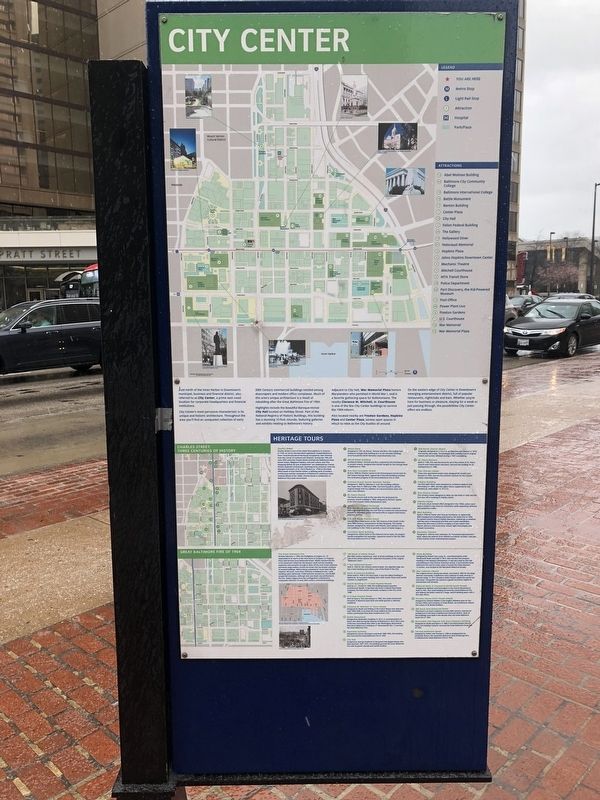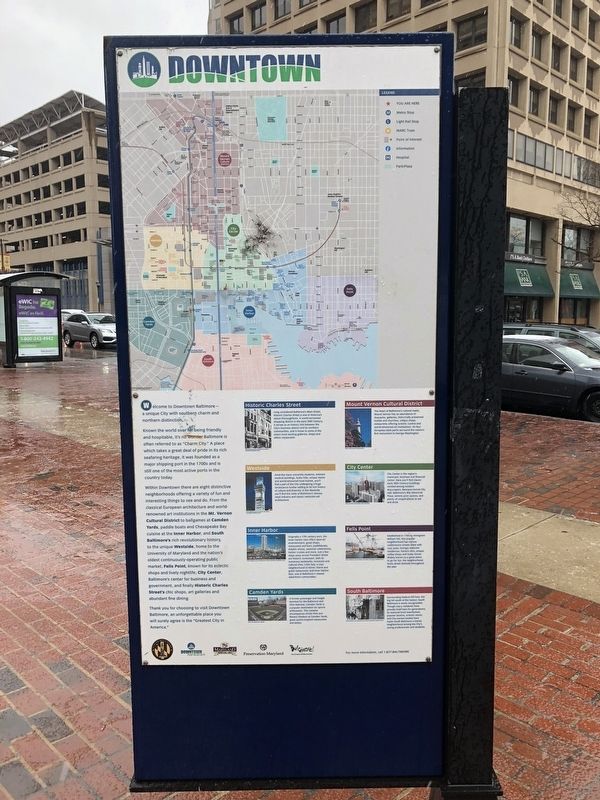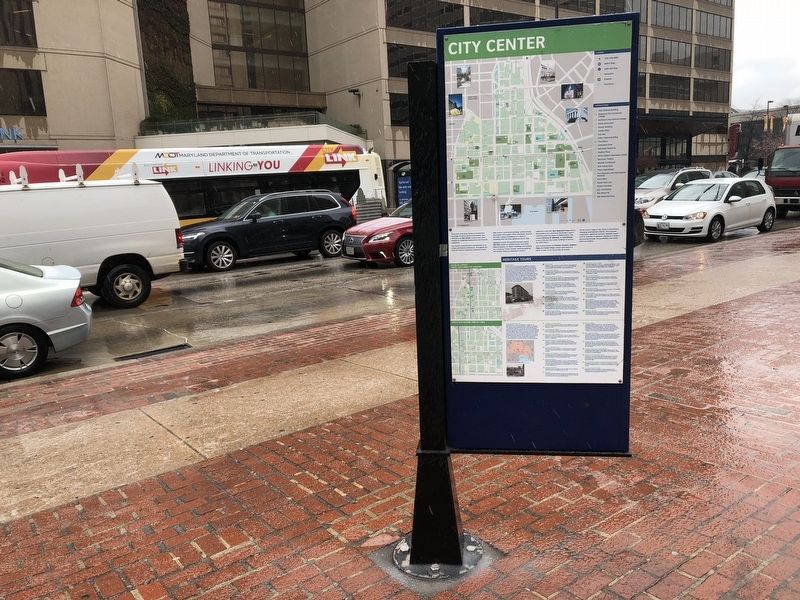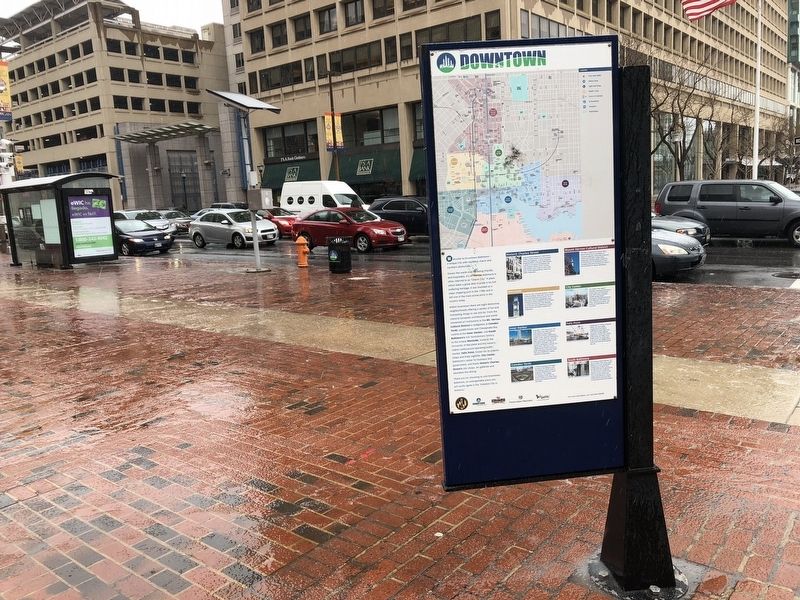Inner Harbor in Baltimore, Maryland — The American Northeast (Mid-Atlantic)
City Center
Just north of the Inner Harbor is Downtown's municipal, business and financial district, also referred to as City Center, a prime east coast location for corporate headquarters and financial institutions.
City Center's most pervasive characteristic is its unique historic architecture. Throughout the area you'll find an unequaled collection of early 20th Century commercial buildings nestled among skyscrapers and modern office complexes. Much of this area's unique architecture is a result of rebuilding after the Great Baltimore Fire of 1904.
Highlights include the beautiful Baroque-revival City Hall located on Holliday Street. Part of the National Registry of Historic Buildings, this building has a stunning 10-foot rotunda, featuring galleries and exhibits relating to Baltimore's history.
Adjacent to City Hall, War Memorial Plaza honors Marylanders who perished in World War I, and is a favorite gathering space for Baltimoreans. The nearby Clarence M. Mitchell, Jr. Courthouse is one of the few City Center buildings to survive the 1904 inferno.
Also located nearby are Preston Gardens, Hopkins Plaza and Center Plaza, serene open spaces in which to relax as the City bustles all around.
On the eastern edge of City Center is Downtown's emerging entertainment district, full of popular restaurants, nightclubs and bars. Whether you're here for business or pleasure, staying for a week or just passing through, the possibilities City Center offers are endless.
Heritage Tours
Charles Street
Charles Street is one of the oldest thoroughfares in America. In 1729, an Act by the Maryland Legislature created Baltimore Town "around and about the house occupied by John Fleming" (now the corner of Lombard and Charles). During the 19th and early 20th centuries Charles Street evolved into Baltimore's best-known artery. Religious freedom, arts and culture, and "the shopping district de luxe of Baltimore" are celebrated by Charles Street's splendid architecture. Spanning three centuries, from the Georgian symmetry of St. Paul's Rectory (1790) to the sleek office tower of One Charles Center, a defining work of modern architecture and the centerpiece of Baltimore's ambitious urban renewal efforts of the 1960s, Charles Street is emblematic of Baltimore City's past and present.
1 Hansa House
Designed in 1907 by Parker, Thomas and Rice, this English half-timbered cottage style building (it is an all-concrete buiding) once housed the North Germany Lloyd Steamship Line.
2 World Relief Building
Architects Parker, Thomas and Rice, inspired by Erechteneum in ancient
3 One East Lexington Street
Built in 1890 by Charles Carson in the Romanesque-revival style for the Central Savings Bank, legend has it that this building checked the northward progress of the Great Baltimore Fire of 1904.
4 Tremont Grand, former Masonic Temple
Designed in 1869 by Edmund G. Lind, this building suffered two major fires in 1890 and 1908. The front façade is still the original design with the addition of a Second Empire style roof and a new entrance.
5 St. Paul's Church
The fourth church built at this site after the fire detroyed the previous church building in 1854, designed by Richard Upjohn in the then-popular Italian Renaissance style.
6 Woman's Industrial Exchange
Built circa 1815 as a private dwelling, the Woman's Industrial Exchange originated after the Civil War as a means for impoverished women to sell baked goods and handcrafts to support themselves and their families.
7 343-345 North Charles Street
Charles Street was known as the "5th Avenue of the South" in the early 20th Century, renowned for its fine shopping. The marble façades, designed by Simonson and Pietsch, were added to these two buildings in the 1920s to provide a touch of Italian elegance.
8
Designed by Alfred aylor in the Classical-revival style, the elegant façade exemplefies the optimistic, expansive mood in the City after the Great Baltimore Fire of 1904.
9 300 North Charles Street
Originally designed as a Y.M.C.A. by Niernsee and Neilson in 1873, this heavily decorated Romanesque style building had its original towers and turrets removed during a 1907 remodeling.
10 St. Paul's Rectory
Built in 1789, this was the home for all of the rectors of St. Paul's church until Preservation Maryland restored the building for its headquarters in 1980.
11 Two Charles Center
These two apartment towers were designed by Conklin and Rossant in 1962, and are the northern anchors for the Charles Center redevelopment.
12 Fidelity Building
The first eight floors were designed by architects Baldwin and Pennington in 1894, and the upper floors, supported by iron framework, were added in 1912-15.
13 One Charles Center
This 24-story tower designed by Mies van der Rohe in 1962 was the first new office building in Charles Center.
14 Charles Center
A 33-acre urban renewal effort designed in the 1950s, public open space created a new focus for Downtown while separating vehicular and pedestrian traffic.
15 B&O
Built in 1906 by Parker and Thomas Architects, to replace the B&O headquarters building destroeyd by the Great Fire of 1904, its opulent interior boasts marble stairways, stained glass windows with the seals of Maryland and Ohio and crystal chandeliers. Above the entryway is a 20-ton sculpture of two heroic male figures, Mercury and Commerce, whose right hand drapes over a steam locomotive.
16 Mechanic Theatre
Designed in 1962 by John Johansen, its "functional expressionism" style, where the exterior form reflects the interior function, was part of the Charles Center redevelopment project.
The Great Baltimore Fire of 1904
The Great Baltimore Fire Sunday February 7, 1904, the firefighters at Engine Co. 15 responded to an alarm at the John Hurst & Company on Hopkins Place and German (now Redwood) Street. Within minutes the fire in the basement rolled into the elevator shaft and the resulting explosion was powerful enough to blow off the roof, break windows and throw large embers across the street into the broken windows of several buildings. Before being contained 31 hours later the fire claimed 140 acres, more than 70 blocks of Baltimore City. 1,526 buildings were destroyed, 2,500 business burned out, and 35,000 people left homeless, although only one death was attributed to the fire. Today's legacy from the conflagration is Baltimore's unequaled collection of early 20th century commercial buildings.
1 100 block of Water Street
The 20th Century warehouse style of all buildings on the north side of this street reflects the waterfront boundary of the original "Baltimore Town."
2 7 East Redwood Street
Built in 1920 for the Citizens National Bank, this dignified high rise has a main banking room that is one of the finest in the City.
3 Bank of America Building
When built in 1929 in Art Deco style, it was the tallest building in Baltimore. Its two-story banking room with mosaic floors and marble columns is magnificent.
4 Macht Building (11-13 East Fayette Street)
Built by A.L. Forrest in 1908, this building boasts beautiful architectural details. It has been the home of the Macht Real Estate Company, the first Jewish real estate company in the City, since 1908.
5 8-12 East Fayette Street
Built by Sperry, York and Sawyer in 1905, this small commercial structure of diamond style brick and white granite is relatively unaltered.
6 Clarence M. Mitchell, Jr. Court House
Designed by Wyatt and Nolting in the French Beaux Arts style and built 1890-1900, it survived the Great Baltimore Fire and stand where courthouses have been located since 1767.
7 Battle Monument
Designed by Maximillian Godefroy in 1814, in the commemoration of those who died during the defense of Baltimore in 1814, this is one of the two monuments (the other is the Washington Monument) that led to Baltimore's sobriquet of "Monumental City." It survived the Great Baltimore Fire.
8 Equitable Building
Designed by Carson and Sperry and built 1889-1894, this building also survived the Great Baltimore Fire of 1904.
9 City Hall
Designed by George Frederick in the grand and elegant Beaux Arts style and built 1867-1875, the building survived the Great Baltimore Fire with its grand rotunda and marble finishes.
10 Peale Building
Designed by Robert Cary Long, Sr., commissioned by artist Rembrandt Peale and built in 1814, this was the first museum building in the Western Hemisphere. It was also used as City Hall and Baltimore's first African American school It survived the Great Baltimore Fire and for many years it housed the Peal Museum collection, now located at the Maryland Historical Society.
11 Zion Lutheran Church
The original church, facing Gay Street, was built in 1807 for the large German community in Baltimore and continues to hold services in German today. In 1913 Theodore Wells Pietsch added the parish hall and tower. The garden has become a gentle lunchtime respite for overworked civil servants.
12 National Bank of Commerce (24-28 South Street)
Designed by Baldwin and Pennington in the French Renaissance style in 1901, this small building survived the Great Baltimore Fire and reflects the bank's need for a large, well-lit banking space with a few side offices.
13 Furness House (19-21 South Street)
Designed by Edward Glidden in the English Palladian style for the Furness Withy and Company of Great Britain, its architecture reflects the culture of its British builders.
14 200 block East Redwood Street
This block is an intact collection of early 20th Century commercial architecture in the heart of Baltimore's financial district. Most of the buildings were built in the decade after the Great Baltimore Fire of 1904.
15 Mercantile Safe Deposit and Trust Company Building
Designed by Wyatt and Sperry in 1885 in the Romanesque Revival style, the building's exterior survived the Great Baltimore Fire of 1904.
16 135 East Baltimore Street
Designed by Parker and Thomas in 1900 as headquarters for Alexander Brown, the venerable Baltimore stock brokerage firm, it withstood the Great Baltimore Fire of 1904.
(Back:)
Downtown
Welcome to Downtown Baltimore — a unique City with southern charm and northern distinction.
Known the world over for being friendly and hospitable, its's no wonder Baltimore is often referred to as "Charm City." A place which takes a great deal of pride in its rich seafaring heritage, it was founded as a major shipping port in the 1700s and is still one of the most active ports in the country today.
Within Downtown there are eight distinctive neighborhoods offering a variety of fun and interesting things to see and do. From the classical European architecture and world-renowned art institutions in the Mt. Vernon Cultural District to ballgames at Camden Yards, paddle boats and Chesapeake Bay cuisine at the Inner Harbor, and South Baltimore's rich revolutionary history, to the unique Westside, home to the University of Maryland and the nation's oldest continuously-operating public market, Fells Point, known for its eclectic shops and lively nightlife, City Center, Baltimore's center for business and government, and finally Historic Charles Street's chic shops, art galleries and abundant fine dining.
Thank you for choosing to visit Downtown Baltimore, an unforgettable place you will surely agree is the "Greatest City in America."
Historic Charles Street
Long considered Baltimore's Main Street, Historic Charles Street is one of America's oldest thoroughfares. A world-renowned shopping district in the early 20th Century, it serves as an historic link between the City's business district and its northern communities, and is home to some of the area's most exciting galleries, shops and ethnic restaurants.
Mount Vernont Cultural District
The heart of Baltimore's cultural realm, Mount Vernon has an abundance of museums, galleries, historically preserved homes and churches, unique shops, restaurants offering eclectic cuisine and world-renowned art institutions. Its four European-style parks surrounding the nation's first monument to George Washington.
Westside
Amid the many university students, eminent medical buildings, funky lofts, unique stores and world-renowned food market, you'll find a part of the City undergoing a huge renaissance further adding to its rich history of culture and diversity. In the Westside you'll find the roots of Baltimore's famous retail industry and classic centuries-old architecture.
City Center
City Center is the region municipal, business and financial center. Here you'll find classic early 20th Century buildings nestled among modern skyscrapers, Baroque-revival City Hall, Baltimore's War Memorial Plaza, serene open spaces, and plenty of unique places to eat and drink.
Inner Harbor
Originally a 17th century port, the Inner Harbor now offers open-air entertainment, great shops, restaurants and bars, paddleboats, dolphin shows, seasonal celebrations, harbor cruises and more. Just a few steps away across President Street are Historic Jonestown, with its numerous landmarks, museums and cultural sites; Little Italy, a cozy neighborhood of ethnic charm and great restaurants; and Inner Harbor East, one of Baltimore's newest waterfront communities.
Fells Point
Established in 1730 by immigrant William Fell, this popular neighborhood has narrow cobblestone streets lined with cozy pubs, lovingly restored residences, historic inns, unique coffee shops and funky stores. Widely known as a great place to go for fun, the neighborhood hosts street festivals throughout the year.
Camden Yards
A former passenger and freight terminal for the Baltimore and Ohio Railroad, Camden Yards is a popular destination for sports enthusiasts. The complex emcompasses Oriole Park and Ravens Stadium at Camden Yards, great sports-inspired restaurants and shops.
South Baltimore
Surrounding Federal Hill Park, the big hill south of the harbor, South Baltimore is easily recognizable. Though many residents have proudely lived here for generations, its restored brick townhomes, popular taverns, eclectic stores and City-owned market have made South Baltimore a trendy neighborhood among the City's young professionals and students.
For more information, call 1-877-BALTIMORE
Erected by City of Baltimore, Downtown Partnership, Maryland Heritage Area, Preservation Maryland and Baltimore! Area Conservation and Visitors Association.
Topics and series. This historical marker is listed in these topic lists: Architecture • Churches & Religion • Disasters • Industry & Commerce. In addition, it is included in the Art Deco series list. A significant historical year for this entry is 1904.
Location. 39° 17.2′ N, 76° 36.822′ W. Marker is in Baltimore, Maryland. It is in the Inner Harbor. Marker is at the intersection of East Pratt Street and Light Street (Maryland Route 2), on the left when traveling east on East Pratt Street. Touch for map. Marker is at or near this postal address: 66 E Pratt St, Baltimore MD 21202, United States of America. Touch for directions.
Other nearby markers. At least 8 other markers are within walking distance of this marker. Theodore R. McKeldin (within shouting distance of this marker); Baltimore Riot Trail (within shouting distance of this marker); McKeldin Square (within shouting distance of this marker); Mob Scene (about 300 feet away, measured in a direct line); McKeldin Plaza (about 400 feet away); Welcome (about 500 feet away); Wendel Bollman (about 800 feet away); The Ship's Head (about 800 feet away). Touch for a list and map of all markers in Baltimore.
Credits. This page was last revised on April 3, 2023. It was originally submitted on March 20, 2018, by Devry Becker Jones of Washington, District of Columbia. This page has been viewed 296 times since then and 23 times this year. Photos: 1, 2, 3, 4. submitted on March 20, 2018, by Devry Becker Jones of Washington, District of Columbia. • Andrew Ruppenstein was the editor who published this page.



